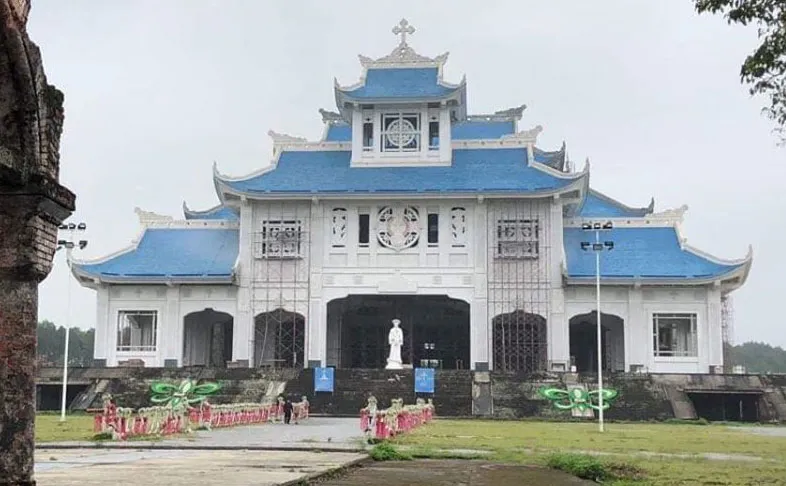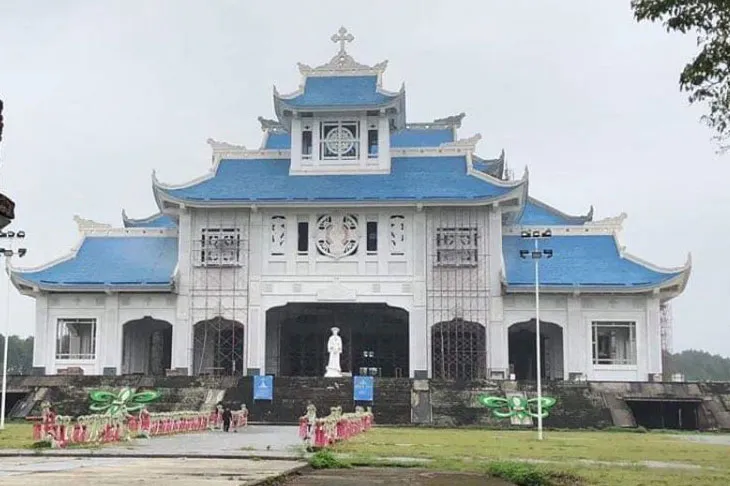
Introduction
Minor Basilica of Our Lady of La Vang, Vietnam is a Roman Catholic sanctuary, commemorating a vision of the Blessed Virgin Mary that was seen there in 1798. An important site of pilgrimage for Catholics in Vietnam, as well as for the Catholic Overseas Vietnamese community. The Apparition Shrine, which was the area where Our Lady appeared, had a renovation in 2008. Areas surrounding the shrine including the Main Sanctuary Gate, were renovated.
Located 40 kilometers from the city of Hue, the Shrine of Our Lady of La Vang marks a site where an apparition of Mary was reportedly seen in 1798.
According to legend, Christians had sought refuge in the rainforests of the Quang Tri Province, during which time many became very ill. While hiding in the jungle, the community gathered every night at the foot of a tree to pray. One night in 1798, in the branches of the tree, a lady appeared, wearing the traditional Vietnamese dress and holding a child in her arms, with two angels beside her.
The Catholics interpreted the vision as the Virgin Mary and the infant Jesus Christ. They said that Our Lady comforted them and told them to boil leaves from the trees for medicine to cure their ills.
In 1802 the Christians returned to their villages, passing on the story of the apparition in La Vang and its message. As the story of the apparition spread, many more visitors and Christians came to pray at this site. In 1820, a chapel was built. From 1830-1885 another wave of persecutions decimated the Christian population, during the height of which the chapel of Our Lady of La Vang was destroyed.
In 1886, construction on a new chapel began and it was renovated in 1924 and 1959. In 1961, the Catholic bishops of Vietnam selected the Church of La Vang as the National Sacred Marian Centre. Today’s church was rebuilt from 1995 to 2004 with a bell tower, a praying square and pilgrimage house.
Basilica of Our Lady of La Vang, Vietnam – Some sources state that the term La Vang was a derivative of the Vietnamese word meaning crying out. Scholars believe it comes from the ancient practice of naming a location for a genus of a tree or plant native to the area, la meaning ‘leaf’ and vang meaning ‘herbal seeds’.
History of Basilica of Our Lady of La Vang, Vietnam
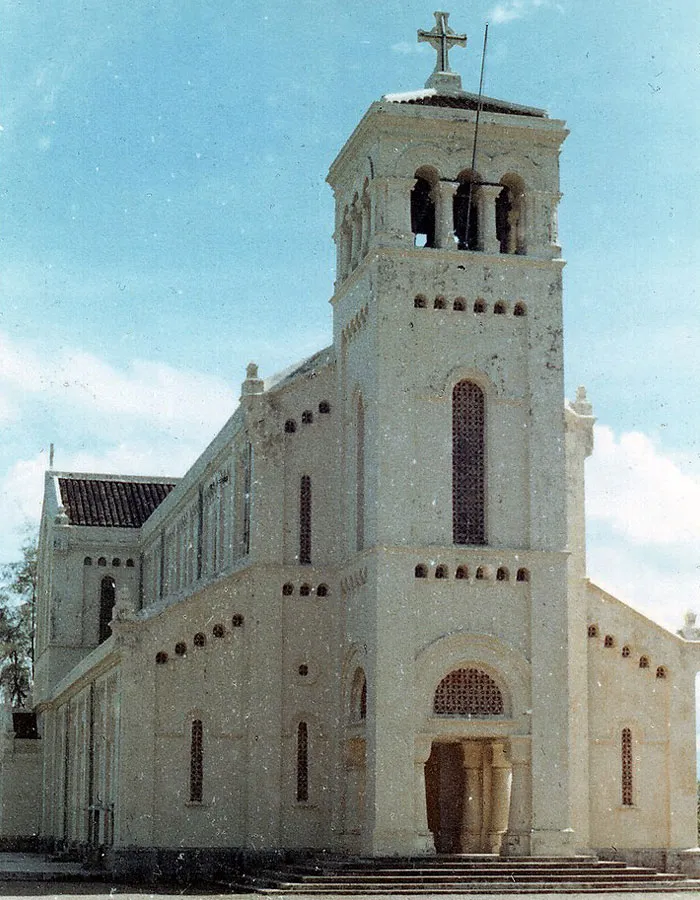
Basilica of Our Lady of La Vang, Vietnam – La Vang or Lavang is a location in Quảng Trị Province, Vietnam. It is the site of the Minor Basilica of Our Lady of La Vang (Đức Mẹ La Vang), a Roman Catholic sanctuary, commemorating a vision of the Blessed Virgin Mary that was seen there in 1798. The site has been rebuilt on several occasions and is an important site of pilgrimage for Catholics in Vietnam, as well as for the Catholic Overseas Vietnamese community. Many Vietnamese Catholic parishes throughout the world are named for Our Lady of La Vang.
The Apparition Shrine, which was the area where Our Lady appeared, had a recent renovation in 2008. Areas surrounding the shrine including the Main Sanctuary Gate, were renovated. The La Vang Boarding House was also recently constructed to accommodate the pilgrims.
The tradition of Our Lady of La Vang dates back to the time when Catholics were executed in Vietnam. Many people sought refuge in the rain forest of La Vang, and many became very ill. They were praying when a lady appeared, wearing the traditional Vietnamese áo dài dress and holding a child in her arms, with two angels beside her.
The people present interpreted the vision as the Virgin Mary and the infant Jesus Christ. They said that Our Lady comforted them and told them to boil leaves from the trees for medicine to cure the illness. In 1961, the Catholic bishops of Vietnam selected the Church of La Vang as the National Sacred Marian Centre.
In 1962, Pope John XXIII declared the Church the Basilica of La Vang. Though there is no official Vatican recognition of this event as a Marian apparition, on June 19, 1988, Pope John Paul II publicly recognized the importance of Our Lady of La Vang and expressed desire to rebuild the La Vang Basilica in commemoration of the 200th anniversary of the first vision. But Pope John Paul II affirmed that there has been no documentation in the Vatican of Our Lady’s Apparitions in La Vang.
Architecture of Basilica of Our Lady of La Vang, Vietnam
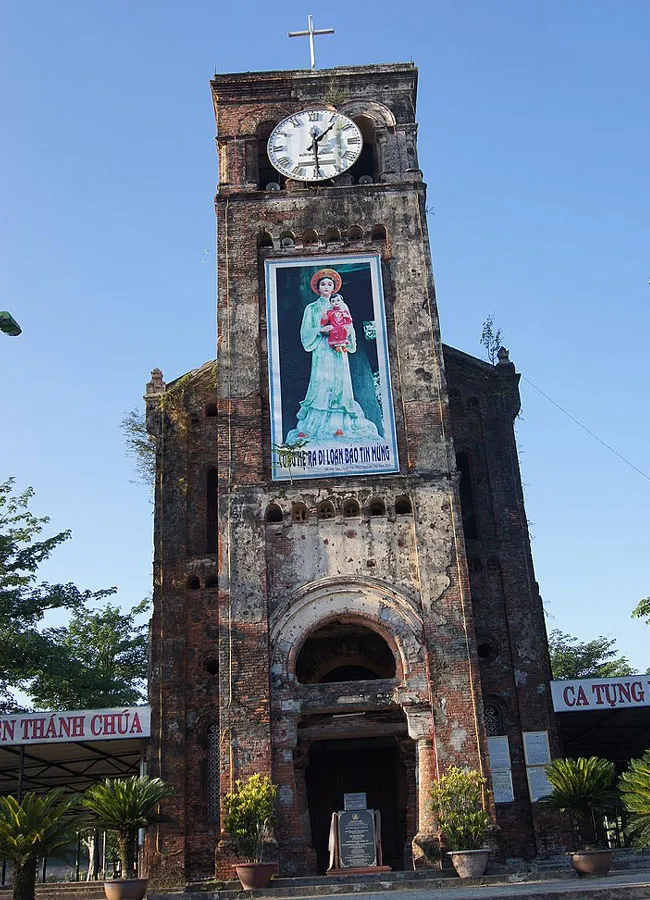
Basilica of Our Lady of La Vang, Vietnam is considered Vietnam’s national shrine. On the feast day of the Assumption, August 15, it is possible to attend solemn masses that draw up to 5 million faithful. Still, no tourist guide, religious or secular, speaks of this enthralling phenomenon in a country that is still for all intents and purposes communist, even if it is taking small steps towards religious freedom.
The Basilica of Our Lady of La Vang, Vietnam complex stands on a plain in central Vietnam, in an area not yet reached by the rapid economic development that is transforming the country.
Basilica of Our Lady of La Vang, Vietnam was built in memory of the apparition of the Virgin and Child, which took place over two centuries ago, in 1798 at the “Cây Lá Vằng” forest (The trees of La Vang), in the province of Quảng Trị (today the territory of the archdiocese of Hue). A statue of the Virgin and Child, dressed in traditional Vietnamese clothes, stands on a stone and concrete sculpture in the form of a copse of trees.
At the end of the 18th century, an edict by Emperor Cảnh Thịnh banned Catholicism from Vietnam, initiating a period of fierce persecution. The Virgin Mary appeared to a group of Vietnamese Catholics who had fled to the forest. Our Lady assured them of comfort and the end of the persecution, indicating a herb (“La Vang”) to treat diseases. Even today, the nuns who together with the parish priest are in charge of the pastoral care of the complex, have areas where they grow this miraculous grass.
The cult for Our Lady of La Vang is widespread not only among Catholics, but also among the faithful of other religions including Buddhists and Protestants, who pray to the Virgin Mary for special graces and healings.
The history of La Vang is intertwined with that of the country and the Church of Vietnam. The church built on the site of the apparition of the Virgin was destroyed during periods of persecution (1830-1885). At the end of the 19th century a new chapel arose, to which Pope John XXIII conferred the title of minor basilica (1961).
With the war and reunification of Vietnam under the communist regime, the shrine was left to rack and ruin, while the authorities attempted to curb devotion and any attempt at restoration. In 1998, Pope John Paul II expressed the desire that on the occasion of the 200th anniversary of the apparition of the Virgin, the sanctuary could be rebuilt.
To date, behind the remains of the old sanctuary, built in the 1800s, a new sanctuary is being built which will be inaugurated in six years. Many dioceses around the world, together with Vietnamese Catholics abroad, are sending donations for the gigantic sacred building that will be on par with the Marian shrines of Lourdes, Fatima, Czestokowa, or Velankanni.
Meanwhile, the complex has been enriched with chapels, hostels, a Way of the Cross and a giant panel dedicated to the 117 Vietnamese martyrs. Each station of the Way of the Cross is accompanied by images and information about some of the martyrs. For example, the station of Jesus who meets Veronica is paired by the presentation of the martyr Thanh Phanxico Nguyen Van Trung, a 22-year-old soldier killed for his faith. The quote taken from him reads: “I am ready to fight and die for my homeland, but do not ask me to renounce my Christian faith”.
Apparition - Our Lady of La Vang
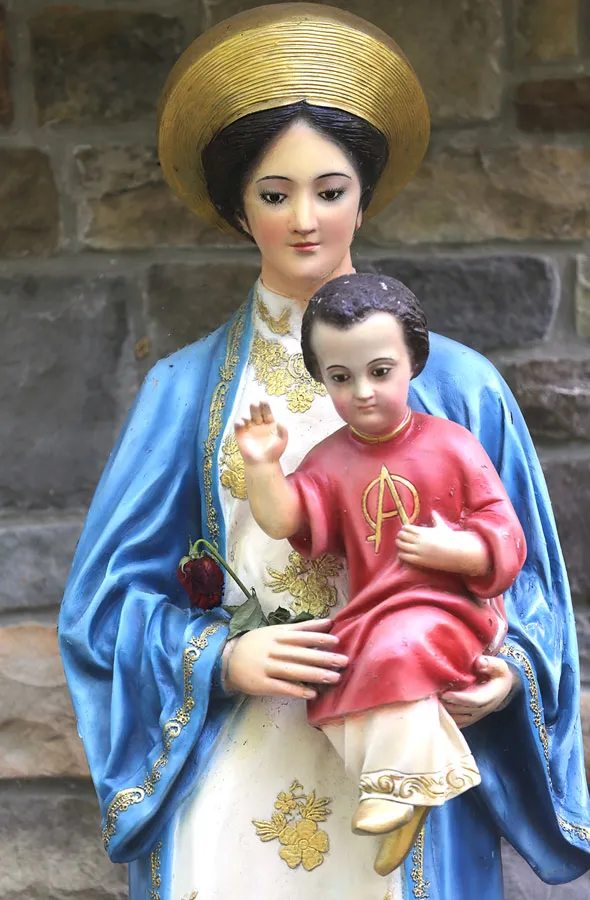
Our Lady of La Vang (Vietnamese: Đức Mẹ La Vang) refers to a reported Marian apparition at a time when Catholics were persecuted and killed in Vietnam. The Shrine of our Lady of La Vang (Basilica of Our Lady of La Vang) is situated in what is today Hai Phu commune in Hải Lăng District of Quảng Trị Province in Central Vietnam.
Fearing the spread of Catholicism, the Cảnh Thịnh Emperor restricted the practice of Catholicism in the country in 1798. Soon thereafter, the emperor issued an anti-Catholic edict and persecution ensued.
Many people sought refuge in the rainforest of La Vang in Quảng Trị Province, Vietnam, and many became very ill. While hiding in the jungle, the community gathered every night at the foot of a tree to pray the rosary.
One night, an apparition surprised them. In the branches of the tree a lady appeared, wearing the traditional Vietnamese áo dài dress and holding a child in her arms, with two angels beside her.
The people present interpreted the vision as the Virgin Mary and the infant Jesus Christ. They said that Our Lady comforted them and told them to boil leaves from the trees for medicine to cure the illness. Legend states that the term “La Vang” was a derivative of the Vietnamese word meaning “crying out”.
Another hypothesis is that La Vang is distorted from the toponym Lá Vằng, lá meaning leaf and vằng meaning jasminum subtriplinerve, a tree species whose leaves are used to made a tisane; according to an ancient practice, a location was sometimes named after a prominent local species of plant or animal.
History of Our Lady of La Vang
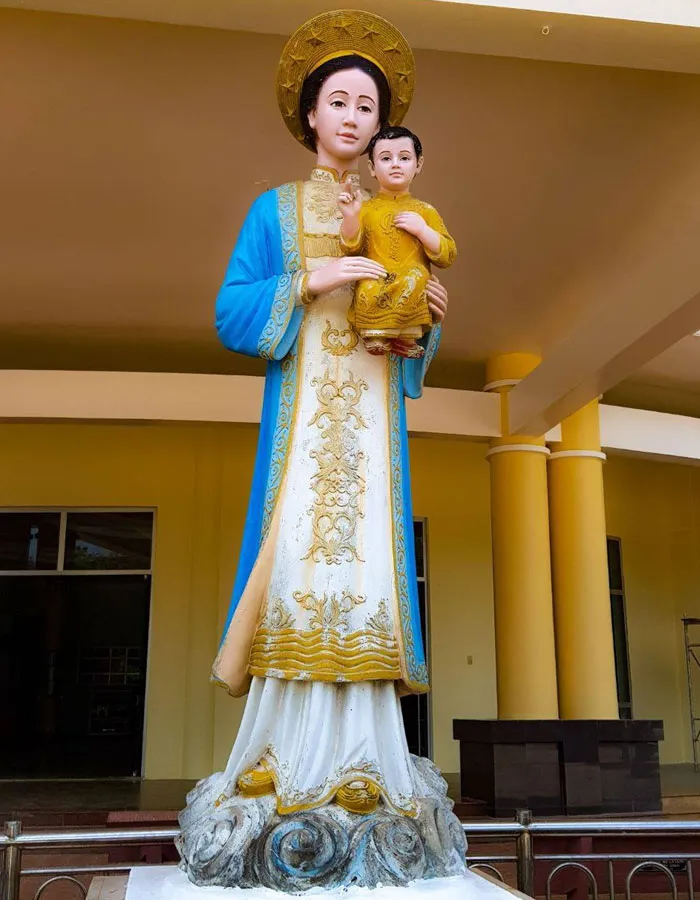
In 1802 the Catholics returned to their villages, passing on the story of the apparition in La Vang and its message. As the story of the apparition spread, many came to pray at this site and to offer incense. In 1820, a chapel was built.
From 1830 to 1885 another wave of persecutions decimated the Catholic population, during the height of which the chapel in honour of Our Lady of La Vang was destroyed. In 1886, construction on a new chapel began. Following its completion, Bishop Gaspar (Loc) consecrated the chapel in honour of Our Lady Help of Christians, in 1901.
On December 8, 1954, the statue of Our Lady of La Vang was brought from Tri Bun back to the holy shrine. The Vietnamese Bishops Conference chose the church of Our Lady of La Vang as the National Shrine in honour of the Immaculate Conception. La Vang became the National Marian Center of Vietnam on April 13, 1961. Pope John XXIII elevated the Church of Our Lady of La Vang to the rank of a minor basilica on August 22, 1961.
Though there is no official Vatican recognition of this event as a Marian apparition, on June 19, 1998, Pope John Paul II publicly recognized the importance of Our Lady of La Vang and expressed desire to rebuild the La Vang Basilica in commemoration of the 200th anniversary of the first vision.
In the Philippines, the Our Lady of La Vang Church at Viet Ville, Barangay Santa Lourdes in Puerto Princesa City in Palawan. Our Lady of La Vang has become a patroness of Puerto Princesa and patroness of Palawan. She was known as Inang Lala (Mother Lala).
In May 2022, Archbishop Joseph Nguyễn Chí Linh announced the dedication and consecration of the new basilica to be during the La Vang congress in 2023, that will happen from 14-15th of August.
Basilica of Our Lady of La Vang
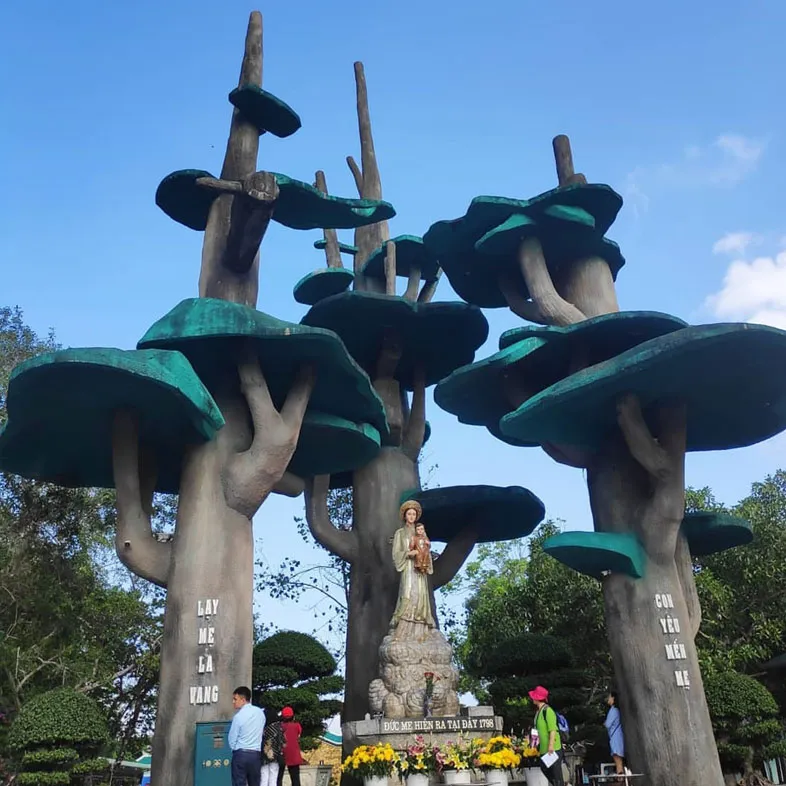
10 years following the establishment of the chapel, the tension between the Vietnamese imperial court and Catholics reached a new height.
From 1830 to 1885, persecution of Catholics took place across the country and a great number of priests were killed. The Catholic population was significantly reduced, and the Church of Our Lady of La Vang was destroyed.
In 1886, local Catholics rebuilt the church, which took 15 years to complete because of its isolated location.
On 22nd August 1961, Pope John XXIII made the church a basilica.
La Vang is the One of Vietnam’s largest Catholic Sanctuaries
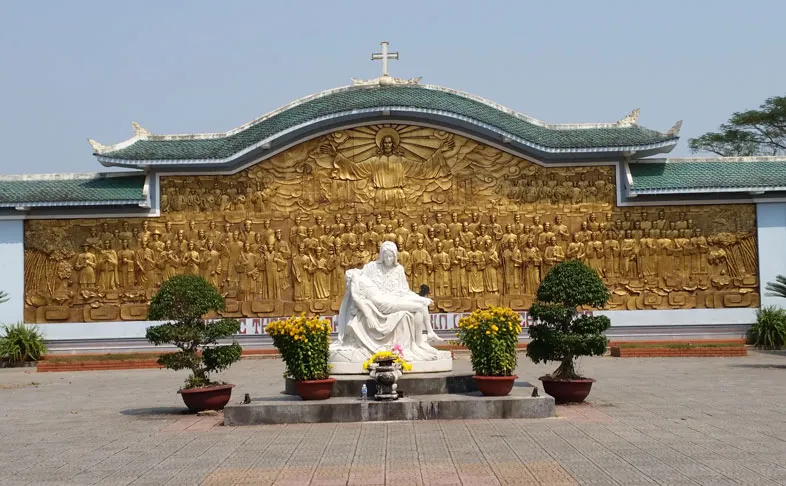
11 years later, the basilica was wrecked during the Easter Offensive of 1972. Only part of the bell tower remained nearly intact during the war.
Though looking tarnished from age, the bell tower still retains its stately appearance.
In 1998, Pope John Paul II recognized the significance of the Marian Apparition at La Vang and expressed his desire to reconstruct the Basilica of Our Lady of La Vang.
To provide pilgrims with a spacious and convenient worship space, local church leaders built a new chapel in 2012. Featuring a vernacular architecture with traditional hipped roofs, this chapel can accommodate up to 5,000 people at any given time.
In front of the bell tower is a spacious square, flanked by sculptures featuring the passion of Jesus Christ as well as Vietnamese martyrs.
At the spot where the Virgin Mary reportedly appeared, visitors will find statues featuring 3 great trees with a statue of Our Lady holding baby Jesus Christ standing in the center.
Inside the shrine, you’ll see a well with a sign that reads “Marian Well”.
Many people who come here drink from the well to pay their respect to the Virgin Mary. They also believe that this water can cure illnesses.
Today, the Basilica of Our Lady of La Vang has become one of the most significant Catholic sanctuaries in the region, drawing thousands of pilgrims each year.
This is also one of the only three Catholic sanctuaries in the country recognized by the Vietnamese government.
At the feast, visitors will find a solemn procession to commemorate the Marian Apparition at La Vang and join Catholic leaders and congregations in the recitation of the Holy Rosary.
Our Lady of La Vang is a Monumental Landmark in Vietnam
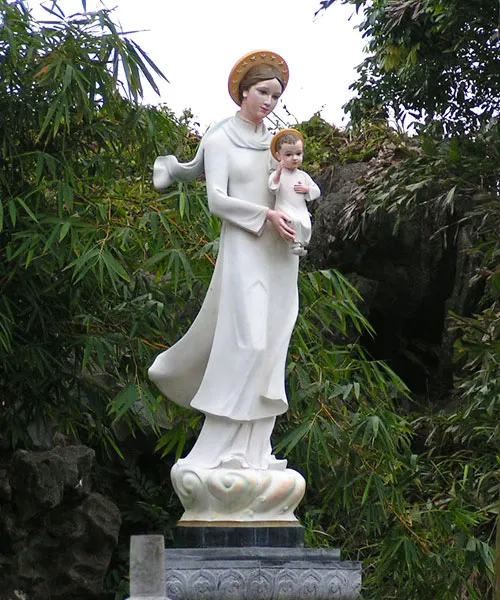
After centuries of wars and destruction, plenty of historical sites in Vietnam have been destroyed. The Basilica of Our Lady of La Vang, a location of significant historic and religious meaning, was no exception. Nonetheless, local believers are still doing their best to preserve the remains of this sacred site and uphold its meaning with feast days and meaningful activities.
Not only is the story of the visitation of the Virgin Mary a crucial point of contact between faith and reality, but it’s also a monumental landmark in our country’s history. The holy shrine offers visitors a glimpse into the historic periods of a bygone era, and to Catholics a newfound appreciation for the hard-earned freedom in practising their chosen religion.
Hopefully, the holy shrine of Our Lady of La Vang will again see thousands of faithful pilgrims making their way to pay their respects once the Covid-19 pandemic is over.
Feast Day
The feast day of Our Lady of La Vang takes place every 3 years in August. The most recent feast day, which was the 31st one, was celebrated on 13th, 14th, and 15th August in 2017. The first feast day was celebrated in 1901.
Mass Time
Weekdays
Sundays
Church Visiting Time
Contact Info
P55V+3V7, Hải Phú, Hải Lăng,
Quảng Trị, Vietnam.
Phone No.
Tel : +84 233 3873 390
Accommodations
How to reach the Basilica
Tan Son Nhat International Airport (SGN) in Ho Chi Minh City, Vietnam is the nearby Airport to the Basilica.
Nha Trang Train Station in Nha Trang, Vietnam is the nearby Train Station to the Basilica.

